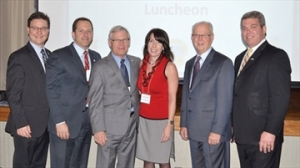
Mayors from the six south Niagara municipalities spoke to a packed crowd at the Italian Canadian Cultural Centre in Port Colborne last week, providing an update about the state of the southern tier. In the photo, from left: Pelham mayor Dave Augustyn, Niagara Falls mayor Jim Diodati, Welland mayor Barry Sharpe, Wainfleet mayor April Jeffs, Fort Erie mayor Doug Martin and Port Colborne mayor Vance Badawey.
Whether it was Niagara Falls Mayor Jim Diodati talking about transportation, Wainfleet Mayor April Jeffs talking agriculture, or host Mayor Vance Badawey discussing the economic gateway, the theme of working as a team was consistent.
“The message is, we’re in this together, as a team,” Badawey said as the annual Mayors of South Niagara Luncheon came to a close at the Italian Canadian Cultural Centre in Port Colborne.
The mayors came together, speaking to municipal and regional staff, as well as local businesses and chamber of commerce members, to discuss the state of the southern tier. Mayors gave presentations on transportation, agriculture, community improvement plans, tourism, the economy and the region’s budget as it relates to the southern tier.
“We’re focused on achieving new investment and employment,” said Badawey, speaking about attempts to attract new business and expand existing businesses. He noted the importance of providing attractive employment lands to bring new business in, and allow current businesses to expand.
While he said there was no “magic bullet” to create employment opportunities, he noted a number of projects local and regional government is working on to promote a bright economic future.
Among those is the east west corridor that connects the QEW to Highways 406 and 140, which Badawey called the first step in a mid-peninsula corridor.
He also explained the importance of industrial community improvements plans, and other incentives to attract business. Those incentives will revolve around tax increment based grants and development charge exemptions.
While Badawey discussed the importance of bringing in new industry, Jeffs described the need to ensure a major sector in Niagara’s economy, agriculture, continues to be strong.
“Traditionally this (urban CIPs) has been applied, quite successfully I might add, to urban renewal efforts, and although Niagara is a leader in this area, urban CIPs don’t necessarily apply to a place like, say, Wainfleet,” she said.
Jeffs said Niagarans have made it clear they want to retain the rural feel that permeates throughout the region, and rural CIPs can do that by helping to convert a barn, for instance, into some sort of commercial establishment, something that would be quite costly without the help of CIPs.
On the topic of transportation, Niagara Falls mayor Jim Diodati discussed the usual suspects – Niagara bordering the United States, major corridors like the QEW, and Highways 406, 405 and 420, the Welland Canal and the rail network that winds through the region – but also pointed out the importance of transportation nodes such as Niagara’s airports.
“There’s a benefit of developing our airports,” he said, recounting a story of a trip he made to an airport in Niagara where a corporate jet landed, the executives then met with clients to discuss what was surely a multi-million dollar deal.
“I asked what the cost of the jet would be and he (an airport employee) said ‘about $35 million.’ I then asked what the airport cost, and he said, ‘about $35 million,’” Diodati said, pointing out how valuable airports can be for corporate executives who just want to fly in, make a deal and fly out.
But it wasn’t just airports, Diodati also noted the importance of bringing the GO Train to Niagara, for which the Region and local municipalities have set a 2015 target to ensure the GO Train is in ahead of the Pan-American Games.
“It’s about getting people to jobs, and getting them to attractions,” he said.
While many in south Niagara believe the Regional budget is north-centric, Welland mayor Barry Sharpe said that’s not the case.
“The budget appears to favour north Niagara…but that’s the wrong perception,” he said.
Sharpe pointed to such projects as new watermain work in Fort Erie, the east-west highway project in south Niagara, and the waste management upgrades for the Humberstone landfill as significant investments by the Region in south Niagara.
He also said Niagara region is positioned well to continue its place atop the green energy industry.
“Niagara has always been the energy capital of Ontario,” he said, adding he hopes that distinction will carry through long into the future.
With the province working toward a target of creating 50,000 new green energy jobs in Ontario, Sharpe said there is much potential for many of those jobs to be located in Niagara.
And part of what will bring in those jobs are the 15 community improvement plans in the region. Augustyn noted the importance of such CIPs, which provide incentives for local businesses to improve and expand by giving them tax breaks and lowering other costs.
Augustyn noted a study that suggests for every $1 spent by government on a CIP program, the private sector spends $9.
“That’s why they’re so important,” he said.
While the region is known, from a tourism standpoint, largely for the Horseshoe falls and the wineries in Niagara-on-the-Lake, Fort Erie mayor Doug Martin said there is much more for visitors to discover.
“The Falls is not the only draw,” he said.
Sites throughout south Niagara, such as the Welland Canal, new community centres that are built or currently being constructed and the Canadian Motor Speedway planned for his home municipality, Martin said there’s plenty to do when tourists come to Niagara.
And those sites will be “especially important when the Pan-Am games come to town,” he said.
The municipalities that border Lake Erie, he said, also have an undiscovered gem: beautiful beaches.
“It’s one of the best kept secrets outside south Niagara,” he said.
Source: Niagara This Week
